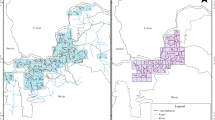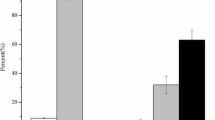Abstract
The red panda Ailurus fulgens Cuvier, 1825 is endemic to the Himalayan-Hengduan Mountains. Many of its ecological traits are still poorly understood although important from a scientific standpoint as a highly specialized bamboo feeder. To understand its food habits and space-use, we carried out a field study from April 2002 to May 2003 in Fengtongzhai Nature Reserve, China. The results showed that red pandas almost exclusively fed on Bashania faberi, but not on Yushania brevipaniculata in the study area. Besides differences in nutritional quality, accessibility to food items is perhaps another factor affecting their utilization of bamboo species. B. faberi leaves are the highest in crude protein, being the primary year-round food source; new shoots and fruits of Sorbus, and Rubus are nutritious and digestible, seasonally occurred in their diet. Red pandas seemed to select most nutritious food items to feed on. The home range of red pandas averaged 2.2 km2 across individuals (2.6 km2 for the males and 1.7 km2 for the females), and overlapped extensively (ranging 18.9–78.1%). No significant difference was found in monthly percentage of total home range used among seasons and sexes. The daily movement distance was 455 m (447 m for the females and 463 m for the males), significantly affected by sexes and months. Our findings indicated that food resource significantly influenced behaviour of red pandas in foraging and space use, and their behavioural responses are adaptive being helpful to energy intake and maintenance.
Similar content being viewed by others
References
Bunnell F. L. and Tait D. E. N. 1981. Population dynamics of bears-implications. [In: Dynamics of large mammal populations. C. W. Fowler and T. D. Smith, eds]. John Wiley and Sons, New York: 75–98.
Carpenter F. L. and MacMillen R. E. 1976. Threshold model of feeding territoriality and test with a Hawaiian honeycreeper. Science 194: 634–642.
Choudhury A. 2001. An overview of the status and conservation of the red panda Ailurus fulgens in India, with reference to its global status. Oryx 35: 250–259.
Deat A., Mauget C. R., Maurel D. and Sempere A. 1980. The automatic continuous, and fixed radio tracking system of the Chize Forest: theoretical and practical analysis. [In: A handbook on biotelemetry and radio tracking. C. J. Amlaner and E. W. McDonald, eds]. Pergamon Press, Oxford: 439–451.
Dierenfeld E. H., Hintz H., Roberston J., Van Soest P. and Oftedal O. 1982. Utilization of bamboo by the giant panda. Journal of Nutriton 112: 636–641.
Garshelis D. L. 2004. Variation in Ursid life histories-is there an outlier? [In: Panda conservation. D. Lindburg and K. Baragona, eds]. University of California Press, Berkeley: 53–74.
Glatston A. R. 1989. Red panda biology. SPB Academic Publishing, The Hague: 1–187.
Hofmann R. R. 1989. Evolutionary steps of ecophysiological adaptation and diversification of ruminants: a comparative view of their digestive system. Oecologica 78: 443–457.
Hu J. C., Schaller G. B., Pan W. S. and Zhu J. 1985. The giant panda of Wolong. Sichuan Science and Technology Press, Chengdu, China: 1–225.
Hume I. D. 1993. Optimal digestive strategies in mammalian herbivores. Physiological Zoology 62: 1145–1163.
Johnson K. G., Schaller G. B. and Hu J. C. 1988. Comparative behavior of red and giant pandas in the Wolong Reserve, China. Journal of Mammalogy 69: 552–564.
McLoughlin P. D., Case R. L., Gau R. J., Ferguson S. H. and Messier F. 1999. Annual and seasonal movement patterns of barren-ground grizzly bears in the central Northwest Territories. Ursus 11: 79–86.
Pradhan S., Saha G. K. and Khan J. A. 2001a. Ecology of the red panda Ailurus fulgens in the Singhalila National Park, Darjeeling, India. Biological Conservation 98: 11–18.
Pradhan S., Saha G. K. and Khan J. A. 2001b. Food habits of the red panda, Ailurus fulgens in the Singhalila National Park, Darjeeling, India. Journal of Bombay Natural History Society 98: 224–230.
Reid D. G., Hu J. C. and Huang Y. 1991. Ecology of the red panda Ailurus fulgens in the Wolong Reserve, China. Journal of Zoology, London 225: 347–364.
Roberts M. S. and Gittleman J. L. 1984. Ailurus fulgens. Mammalian Species 222: 1–8.
Sandell M. 1989. The mating tactics and spacing patterns of solitary carnivores. [In: Carnivore behavior, ecology and evolution. J. L. Gittleman, ed]. Cornell University Press, Ithaca, New York: 164–182.
Searle K. R., Hobbs N. T. and Shipley L. A. 2005. Should I stay or should I go? Patch departure decisions by herbivores at multiple scales. Oikos 111: 417–424.
Seaman D. E. and Powell R. A. 1996. An evaluation of the accuracy of kernel density estimators for home range analysis. Ecology 77: 2075–2085.
Sibly R. M. 1981. Strategies of digestion and defecation. [In: Physiological ecology: an evolutionary approach to resource use. C. R. Townsend and P. Callow, eds]. Sinauer Associates, Inc., Publishers, Sunderland, Massachusetts: 109–141.
Siew T. W., Christopher W. S. and Laurentius A. 2004. Home range, movement and activity patterns, and bedding sites of Malayan sun bears Helarctos malayanus in the Rainforest of Borbeo. Biological Conservation 119: 169–181.
Silverman B. W. 1986. Density estimaton for statistics and data analysis. Chapman & Hall, London: 1–22.
Stirling J. and Derocher A. 1996. Factors affecting the evolution and behavioral ecology of the modern bears. Conference of Bear Research and Manage 8: 189–204.
Van S. 1982. Nutritional ecology of ruminant. O and B Books, Oregon: 1–528.
Warnell K. J., Grissey S. D. and Oftedal D. T. 1989. Utilization of bamboo and other fiber sources in red panda diets. SPB Academic Press, Netherlands: 1–000.
Wei F. W., Wang W., Zhou A., Hu J. and Wei Y. 1995. A preliminary study on resource selection and foraging strategies of red pandas. Acta Theriologica Sinica 15: 259–266.
Wei F. W., Feng Z. J., Wang Z. W. and Hu J. C. 1999a. Current distribution, status and conservation of wild red pandas Ailurus fulgens in China. Biological Conservation 89: 285–291.
Wei F. W., Feng Z. J., Wang Z. W. and Li M. 1999b. Feeding strategy and resource partitioning between giant panda red pandas. Mammalia 63: 417–430.
Wei F. W., Feng Z. J., Wang Z. W., Zhou A. and Hu J. C. 1999c. Use of the nutrients in bamboo by the red panda (Ailurus fulgens). Journal of Zoology, London 248: 535–541.
Wei F. W., Wang Z. W. and Hu J. C. 2000. Habitat use and separation between the giant panda and the red panda. Journal of Mammalogy 80: 448–455.
Worton B. J. 1989. Kernel methods for estimating the utilization distribution in home range studies. Ecology 70: 164–168.
Yi T. 1997. Sichuan Bamboo species. China Forestry Press, Beijing: 1–58.
Yonzon P. B. 1989. Ecology and conservation of the red panda in the Nepal-Himalaysas. PhD thesis, Maine University.
Zhang Z. J., Wei F. W., Li M. and Hu J. C. 2006. Winter microhabitat separation between giant and red pandas in Bashania faberi bamboo forest in Fengtongzhai Nature Reserve. The Journal of Wildlife Management 70: 231–235.
Zhang Z. J., Wei F. W., Li M., Zhang B. W., Liu X. H. and Hu J. C. 2004. Microhabitat separation during winter among sympatric giant pandas, red pandas and tufted deer: the effects of diet, body size, and energy metabolism. Canadian Journal of Zoology 82: 1451–1458.
Author information
Authors and Affiliations
Corresponding author
Additional information
Associate editor was Joseph F. Merritt.
Rights and permissions
About this article
Cite this article
Zhang, Z., Hu, J., Yang, J. et al. Food habits and space-use of red pandas Ailurus fulgens in the Fengtongzhai Nature Reserve, China: food effects and behavioural responses. Acta Theriol 54, 225–234 (2009). https://doi.org/10.4098/j.at.0001-7051.017.2008
Received:
Accepted:
Issue Date:
DOI: https://doi.org/10.4098/j.at.0001-7051.017.2008




